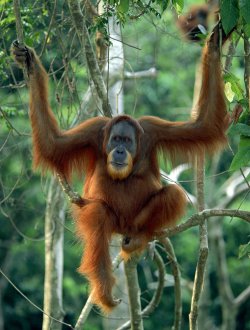
Sumatran Orangutan

Orang-utans have brown and rust-colored shaggy fur.
They weigh an average of 50 kg (110 lb) and can weigh over 90 kg (200
lb). The orang-utan lives in tropical, swamp and mountain forests,
where it eats mostly fruit, leaves and insects. The orang-utan is arboreal and
diurnal. It exhibits a sophisticated use
of tools for gathering food. Twigs and branches are utilized to construct a
large nest-platform in a tree to sleep in at night.
Adult orang-utans
are generally solitary, except when a male and a female are together for mating.
The home range of an adult male
usually overlaps the ranges of several adult females. Orang-utans are not territorial. Most animals in a given
area appear to maintain a loose relationship, although adult males are hostile
to one another. A single young is usually born about every six years.
The
orang-utan was once found throughout Indo-China, Malaysia and north to China. In historical times it has only been
known from Sumatra and Borneo. About 100
years ago it was present in most of the rain forest areas on these islands;
however, it was never found in large numbers. It has declined drastically since
then. The major causes of the orang-utan's decline have been 1.) in the past,
capture for the pet and zoo trade, especially the capture of young, which
usually involved killing the mother; and 2.) habitat loss, especially through
permanent conversion to oil-palm plantations and for logging.

Why is the Sumatran Orangutan becoming an Endangered Specie?
The major threats have been 1.) in the past, capture for the pet and zoo trade, especially the capture of young, which usually involved killing the mother; and 2.) habitat loss, especially through permanent conversion to plantations and for logging.
In selectively-logged areas, orang-utan densities decrease on average by 60 % of pre-logging levels. Continued logging effectively eliminates orang-utans in the secondary forest left after timber depletion. In one such area, orang-utan density fell by approximately 90 % within a year after selective logging followed by continued timber poaching. (van Schaik et al. 2001)
"The major threats to the survival of Sumatran orang-utans are identified as habitat loss (mainly from conversion to oil palm plantations), habitat degradation and habitat fragmentation. The immediate causes of this are identified as weak compliance with regulations and laws; weak law enforcement and the weak legal environment. Corruption is identified as the ultimate causal factor underlying these three immediate causal factors, along with a frontier mentality and bureaucratic constraints." (Yarrow Robertson & van Schaik 2001)
(Taken from http://www.animalinfo.org/species/primate/pongpygm.htm)
Want to learn more about the beautiful Sumatran Orangutan?